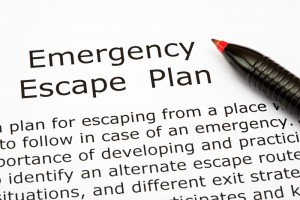Having a fire in the home is an obviously terrifying event. Because chaos can break out so quickly, it is important to have a rehearsed, familiar escape plan in place so everyone knows where to go if a fire actually breaks out. This plan could literally be the difference in escaping or losing your life.

- Create a Floor Plan . If you look on any hotel room door, you will see a floor plan of the area and a fire escape route. You should create a similar plan for your home, including detailed plans for every floor and possible escape areas, such as all doors and windows. Be sure to make note which exits are not direct exits to the ground, but that have areas such as a roof or garage that can be used if necessary.
- On your floor plan, you should show a main and secondary exit route for every room. For instance, the door out of the room should always be considered the first emergency exit. However, there may be times when the fire prevents that exit from being used, so outlay the play to exit via windows.
- Have a priority order of who is going to help each other in case of a fire. For instance, if you have elderly or young children in the home, someone should be responsible to help them get out during a fire. This will save time if a fire were to occur and those valuable seconds could be enough to save a life.
- Have an organized meeting place for everyone to go outside of the home in case of fire. This will allow you to know if everyone was able to get out safely. Buy a prepaid phone for this area and secure it. Take the time to put everyone phone numbers into the phone so you can check if anyone is not in the meeting area. They may not have been home during the fire and this will avoid someone rushing into the building thinking they are there. This phone should also have all emergency phone numbers programmed, such as police and fire. Contact them from this phone, not your house phone, as you should get out of the house as quickly as possible.
- Finally, practice, practice, practice. The entire family should practice your plan until everyone has their roles down perfectly. From that point, schedule a fire drill at least twice a year to re enforce the training. It may help to actually have an unannounced drill once a year as well, just to make sure everyone is able to fulfill their role when they are not aware it is only a drill.
